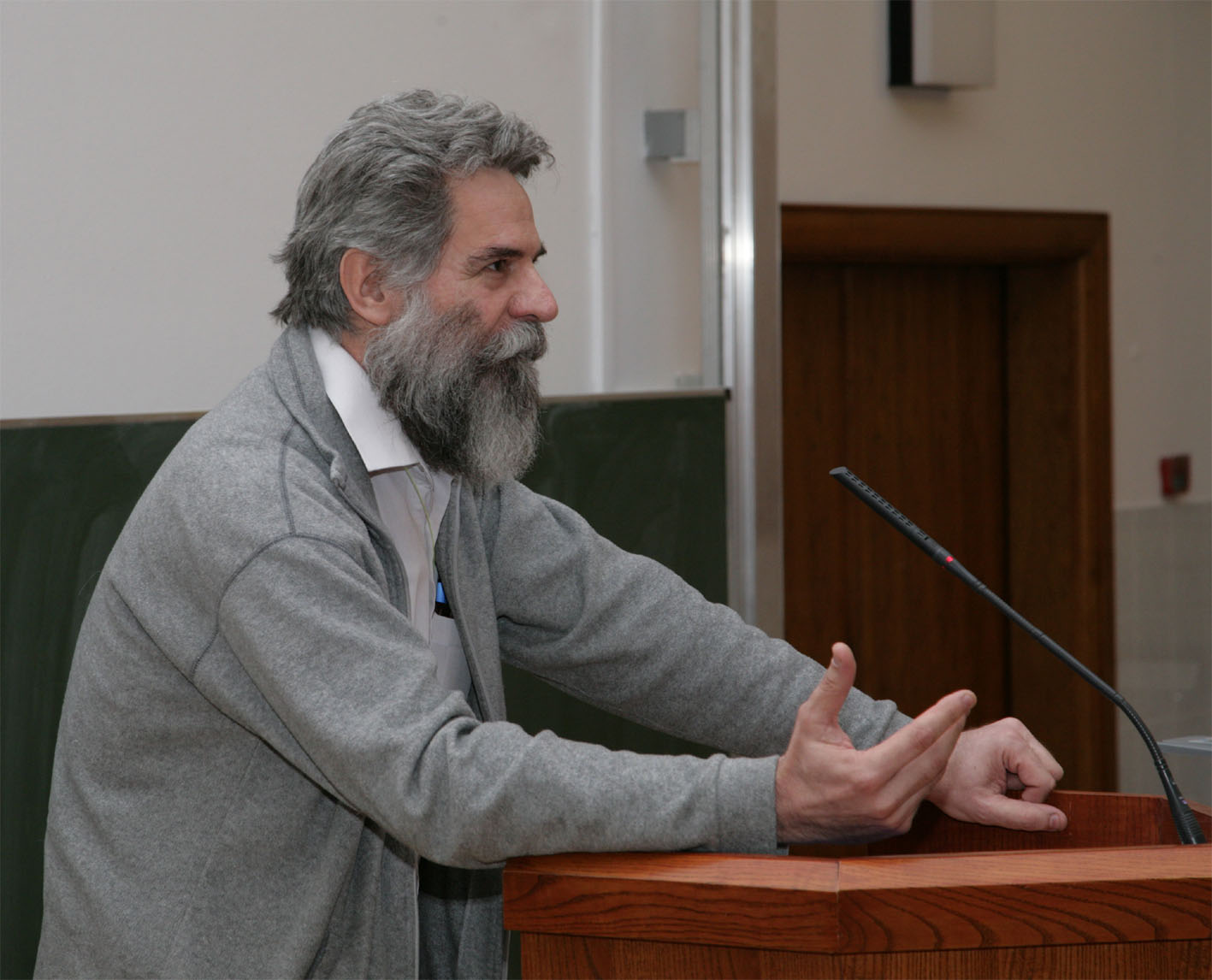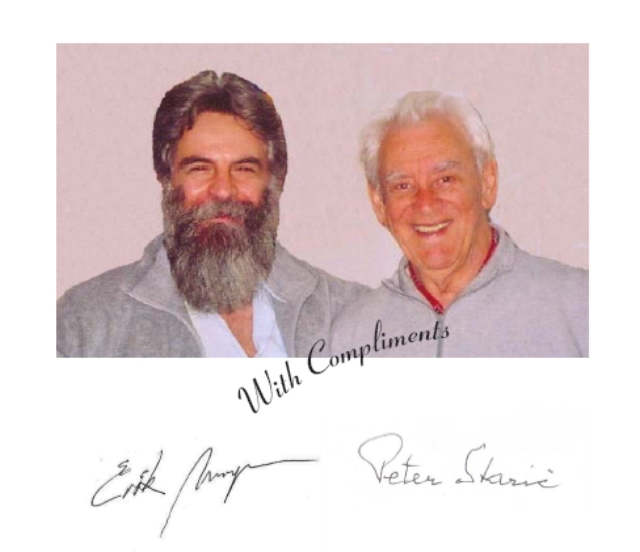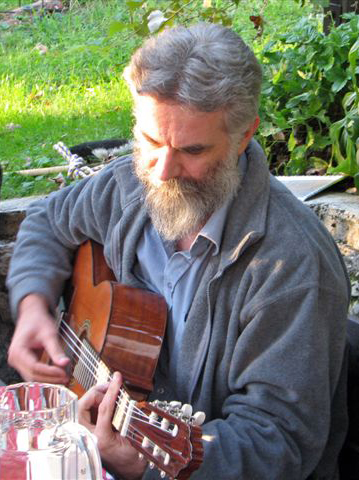 | Erik Margan is a specialist in electronics working in Slovenia, with roots from Croatia. He participates a particle physics experiment called ATLAS at the Large Hadron Collider at CERN, Geneva, Switzerland. The ATLAS detector will search for new discoveries in the head-on collisions of protons of extraordinarily high energy. |

Erik Margan is a specialist in electronics working in Slovenia at the Institute Jožef Štefan (IJF), Ljubljana. His roots are from Croatia where he attended primary and secondary school and made his first experiments that led him to the study of electrotechnics in Ljubljana. He participates a particle physics experiment called ATLAS at the Large Hadron Collider at CERN, Geneva, Switzerland. The ATLAS detector will search for new discoveries in the head-on collisions of protons of extraordinarily high energy. ATLAS will learn about the basic forces that have shaped our universe since the beginning of time and that will determine its fate. |

| This self caricature portrait says it all. I went into the same high school class in Rijeka, Croatia (Sušačka Gimnazija) Class IV A, with Erik. We played chess on a regular basis in between classes at the last row of benches. We also played in the first rock and roll band called Mac. He played lead guitar, like Eric Clapton. Erik was better in guitar techniques then, than I am now. I am just able to hide the fact successfully so far. (Wasn't so successful in hiding Clapton's talent although we met many times in New York). Erik is capable of drawing everything on anything. Born artist. No wonder he ended up in science, although true artists never call themselves an artist. I guess the same goes for true scientists. Funny, modest and overall brilliant. What a pleasure, Nenad N. Bach New York, August 14, 2008 |
| Erik Margan, My CV Contrary to widespread belief, when I was born, back in 1954, I was very young and inexperienced. It took me four years to recognize that the world as we know it was not well designed from the beginning (if you ask me, I think that the beginning of everything was owed to an experiment that went out of control - otherwise there would not be any Big Bang in the first place!) and that we should do something to improve it. I started that improvement by educating people who were close to me - my parents. But after two years of unsuccessful trials I finally gave up and decided that social engineering is definitely a blind alley. So I started experimenting with objects around me, and I remember how enthusiastic I was to discover that objects did not make complains when you smashed them. Better still, they did not make complains even if you ignored them. It was a nice discovery. My parents noticed my interest in things and soon I was receiving didactic toys for birthdays, New Year, and other holidays. For my eighth birthday I got a big 'Electro-Pioneer' box. For a while I enjoyed playing with the magnet and iron dust. Pretty soon there was iron dust everywhere, but, fortunately for me, it could be collected easily - with the magnet, of course. Too easy and not much fun. But then I found a battery and a 3V lamp and - there was light! Now, that was something! But not for long, though: the battery was out in less than an hour. I went to sleep that night thinking how wonderful it would be to have an inexhaustible power source. At five in the morning I was up with a new idea. In less than ten minutes I put together a lamp in a socket, a switch, wires and a plug, and connected it to the 220V AC mains. Then I pressed the switch. The effect was, well, lightning. But I was disappointed. Certainly, the makers of 3V lamps should be forced by law to put on a warning to the customers that they will be violating the user's license by exposing the lamp to higher voltages. But, hey, that was in the early sixties, when nobody cared much about anybody's rights anyway. The big bang of the unfortunate lamp and the 10A fuse woke up my mother and she came to see what the hell our neighbors were up to. I told her it was nothing and that she could go back to sleep and I will clean up the mess. Then my mother gave me the first lesson on electromagnetic theory. It was a painful experience, but it was worth it, otherwise you would not be reading this and gaining from my experience. Clever people do learn from the experience of others and not their own, so I was told. But that was on another, less dramatic occasion, and I never thought twice about that. Until it was too late. I remember how happy I was whenever I could have some first hand experience of anything in connection with electricity. Most of the time I got 'smoked up' with blown electrolytic capacitors, burned by touching hot resistors, vacuum tubes, and later power transistors, shaken a few times by touching the AC mains, destroyed a few pieces of furniture with the soldering iron and a few carpets with solder drops. I was making all sorts of errors, so I was learning very fast. Only much later did I realize how thoughtful of me it was that I did not follow the wishes of my father to go for a medical profession, or become a chemist, like my mother. Later in school my pace of learning slowed down considerably, since all my teachers were trying hard to discourage that kind of acquiring knowledge. And they almost succeeded. But in 1968 I joined the orthodox rocker movement and adopted the 'flower power' philosophy. I was playing a guitar, daydreaming of making my own amplifier, with all the psychedelic sound effects built in, which even Jimi Hendrix himself would envy. Then the Manson ‘family’ killed Sharon Tate and her friends. Of all the flower power, only the flower powder remained. But I was still making amplifiers. Gradually, I became an ‘audiophile’, a Hi-Fi fan, but with a highly technical inclination. I think I have spent more time listening to amplifier distortion than to music. Which is a shame! At that time oscilloscopes were a rare commodity, even amongst professionals, and like many of my colleagues most of my experience came from my ears and from a modest AVO meter. But I managed to build a few circuits (one of them was the differential distortion measurement circuit, published by Peter J. Baxandall in Wireless World) which expanded the instrument measurement capabilities and resolution enough to do some serious distortion analysis. In 1981 I started to work at the 'Jožef Stefan' Institute I witnessed the early success of LCDs: initially, the cost of a wrist watch with a LC display was nearly two month’s wages of a general manager; three years later, you could buy a pencil with a built in LCD watch for US$1.95 and without the watch for 2.95! And I would not be surprised if the present mobile phone frenzy ends up by having a mobile phone as a surprise present in a box of detergent! No, we were not responsible for this market overflooding. We were busy doing research on multiplex LCD driving and in 1982 we demonstrated the world’s first 200120 dot display. No one we have spoken to knew what to do with it, so we decided to make a small portable oscilloscope to show the money people more clearly what they will be investing in. The directors of Iskra, the major Slovenian electronics company, were interested and in autumn of 1983 we had a working prototype of the 'IskraScope LCD' at a local electronics fair. Unfortunately, the German Metrabyte came up with a similar thing some two months earlier, so they collected the cream of the interest, because they were selling! Next year, we came up with a new model, 8–bit resolution, 2MHz bandwidth, 2M samples per second (S/s) in real time, and 10MS/s in equivalent time, microprocessor controlled, with a membrane keyboard, a 2k signal memory length, 10 screen long signal memories, to which you could apply some rudimentary math, a built in 3 digit DMM, an analog XY plotter output, and a galvanically isolated RS-232 serial digital interface, with a 6–hour battery life, and a mass of 2.5kg. Again, it was a fine prototype. But Metrabyte was still selling strongly its last year’s 250kHz model. For the next few years, people of Iskra-Commerce went from one fair to another showing the prototypes, but they never knew what to say to a potential customer asking by what time they could make 1k pieces and for how many kUS$. Then, in 1987, Sony came in with their 50MHz handheld model (later sold under the Tektronix trademark) and we were out. Moral: never show a prototype to anyone but your own boss! Although we have tried to revive the project, first as an optical time domain reflectometer using a 20MHz ADC (with which we could measure a 0.5dB optical mismatch in a 50km fiber and locate it within 1m resolution in real time), and later as a data acquisition unit with a small nuclear magnetic resonance imaging device, Iskra was never interested enough, mostly owing to the general financial crisis and the galloping inflation in ex-Yugoslavia. It was in those years that I came to know Peter Starič, who was then also working at IJS, but in a different department. Since I was involved mainly in designing the analog input and the data acquisition part of the ’scope, his fresh memories of what he had done at Tektronix, as well as his rich library, which he was sharing generously, helped me a lot. Later Peter went to the 'Milan Vidmar' Institute A few years later Peter retired and I took over, thanks to the invitation from the EIMV director, Prof. Maks Babuder. You can not imagine how nice it was to revive my memories of the unfortunate 3V lamp, but on a much, much larger scale! When the isolation being tested breaks down, the Marx generator flashes a 60cm (about 2feet) long arc with a bang of a small clap of thunder! The problem with recording any event with such a signal is that there is no 'ground' reference - everything floats at many tens of volts or even a kV, depending mostly on the inductance of the particular ground path and the capacitance of a surface. You can not just connect two instruments together - the transients within the loop formed by the signal connection and the grounding power cables can be high enough to destroy both instruments. And we did not have just two instruments: there was the motor and the electronic servo-control driving the variac for the high voltage charger, the stepper motor for adjusting the spark gaps, measured by a 13 bit displacement encoder, the DC HV meter, the high speed digital oscilloscope, the laser trigger, the PC which was controlling everything, and a number of safety devices, the most important of which was the short circuit discharge, driven pneumatically. Now try to imagine the network of control signals and power supplies forming whatever loops they can, over an aarea of half a basketball field! No wonder it was a miracle that on the first test no instrument failed - certainly, Mr. Edsel Murphy must have been sleeping after a hard day's work! But the EMI generated was such that it span some 7 ’scope screens at nominal resolution - clearly too much 'grass' and no signal to measure. It took me and a colleague, Marko Janša, nearly two years of painstaking trial and error to find a configuration of connections, decouplers, filters, grounding and shielding by which we achieved an EMI attenuation of 130dB, needed to make the measurements with a 1% resolution. Then, in 1994, I returned to IJS, this time to the Experimental Particle Physics Department, led by Prof. Marko Mikuž, where I became involved in an international collaboration at CERN, In a few years time, probably in 2007(8?), the collider will be ready to recreate (in part) the conditions present at the birth of the Universe. If you will then hear the news that 'the scientists at CERN have made a Big Bang again', you will know who to blame for it! Erik Margan |

| Priprema 'bačvice' sa silicijevim detektorima (SCT) u čistoj sobi: svaki zlatno-smeđi kabel (aluminij na kaptonu) vodi do jednog od detektorskih modula, svaki modul ima 6 čipova, svaki čip ima 128 kanala, svaki kanal čita po jedan 'pixel' ili 'strip'; SCT ima tri cilindra, jedan unutar drugog: |
|
|

Wideband AmplifiersStaric, Peter, Margan, Erik1st ed. 2006. Corr. 2nd printing, 2007, XIII, 634 p. With CD-ROM., Hardcover ISBN: 978-0-387-28340-1 About this book There are many books discussing electronic circuit design which include a chapter or two dedicated to wideband and high-speed circuits and instrumentation. In most of those books the way of achieving a high bandwidth relies almost exclusively on the selection of semiconductor devices fast enough to do the job. Only a few of them go deep enough into specific details useful for starting the high-speed circuit design from scratch; fewer still dedicate enough space to identify the causes for bandwidth limitation, let alone the remedies and solutions possible with careful and systematic consideration of active and passive component interactions and specific circuit topology selections. There are also many books discussing circuit analysis, modeling and performance optimization strategies; almost none, however, offers also the complete introduction to mathematical procedures required for a successful design, particularly if time-domain or transient performance is of prime importance. Wideband Amplifiers attempts to cover both of these requirements, starting from the basics of mathematical procedures and circuit analysis but also offering the more advanced topics of system optimization and synthesis, along with the complete mathematical apparatus required. We have tried to show the circuit examples in such a way that the main principles for achieving high bandwidth are clearly exposed, independently of the actual device technology used in the circuit realization. At the same time we were striving not to loose sight of the everyday needs of a circuit design engineer, so we have intentionally limited the contents of mathematics to the necessary minimum. While some of the derivations require a degree of previous mathematical knowledge, we have taken care to include the trivial steps in order to help a less experienced reader to follow the subject easily. For those who want answers more immediately, the computer routines on the accompaining CD will be of help. In this way we hope that Wideband Amplifiers will have a more lasting value, both as a learning guide and as a reference design manual. Written for: Amplifier and High-speed instrumentation electronics design engineers, electronics engineers in general interested in high-speed circuit design and application, students interested in High-Speed Amplifiers and Instrumentation Keywords: Bessel Poles for System Transient Optimization Inductive Peaking Compensation Techniques Laplace- and Fourier transform (FFT) Modern High-Speed IC-Amplifiers Wideband Amplification and Instrumentation Design Source: www.springer.com |
| ZONE Reviewer: Dennis Feucht On rare occasion, a book is published that the analog designer wants to have within arm's reach near one's desk. This 640 page hardbound book which comes with a matching CD is one of them. The authors live in Slovenia, but hardly far from the analog state-of-the-art. The two are from the Jozef Stefan Institute in Ljubljana. I remember passing Peter occasionally while walking around the Tektronix campus in Beaverton, OR when he worked there and Erik has long been in contact with some of the leading oscilloscope vertical amplifier designers from Tek. The book has that European penchant for being theoretically complete and in-depth, in this case on the subject-matter of how to design fast dc amplifiers. Much of what was once proprietary company information at Tek is now explained in detail in the book. Yet, 25 or more years later, these concepts are not widespread in the electronics industry. That fact was also a motivation for why I wrote my book, Analog Circuit Design (ACKTS), which put into book form three large engineering looseleaf notebooks from my T&M instrument design work. It is now being offered as a four-volume set on CD or via e-mail attachment. Wideband Amplifiers is a good complement to it because it presents in more complete form what ACKTS covers in some of the High-Performance Amplifiers volume. Source: www.analogzone.com |

Erik Margan with his guitar.
ATLAS is a particle physics experiment at the Large Hadron Collider at CERN. Starting later in 2008, the ATLAS detector will search for new discoveries in the head-on collisions of protons of extraordinarily high energy. ATLAS will learn about the basic forces that have shaped our universe since the beginning of time and that will determine its fate. Among the possible unknowns are the origin of mass, extra dimensions of space, microscopic black holes, and evidence for dark matter candidates in the universe. Source: www.atlas.ch |
Formated for CROWN by prof.dr. Darko Žubrinić
Distributed by www.Croatia.org . This message is intended for Croatian Associations/Institutions and their Friends in Croatia and in the World. The opinions/articles expressed on this list do not reflect personal opinions of the moderator. If the reader of this message is not the intended recipient, please delete or destroy all copies of this communication and please, let us know!